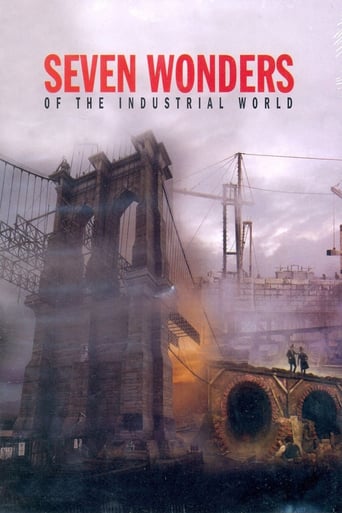Hotwok2013
"The Seven Wonders Of The Industrial World" focuses on some of the most ambitious engineering achievements ever undertaken. Six out of the seven were done in the 19th century with only the construction of the Hoover Dam in the USA being a 20th century project. Taken in chronological order, (though not in the order they were televised), they were 1.The Bell Rock Lighthouse. It was built under the guidance & religious zeal of Robert Stevenson. Lying 12 miles off the west coast of Scotland, many ships & lives had been lost around its treacherous waters. 2.The Sewer King. The construction of London's sewer system was masterminded by Joseph Bazalgette. The Thames river had become so terribly polluted that by the hot summer of 1851 it had caused "The Great Stink" forcing parliament to take action. 3. The Great Ship. Designed by Isambard Kingdom Brunel to circumnavigate the globe & carry sufficient fuel to do so, the ship named "The Great Eastern" was way ahead of its time. 4. The Transcontinental Railway. To connect the east & west coasts of the USA by rail had been a dream of Abraham Lincoln's before his assassination. 5. The Brooklyn Bridge. Begun by John Roebling & completed by his son Washington Roebling it was an ambitious & very dangerous undertaking. Work on the bridge's foundations had caused many deaths & illness from what is now called "the bends". After Washington, himself, became seriously ill his wife Emily stepped in. She had familiarised herself with every aspect of her husband's work & devotedly saw it through to completion. 6. The Panama Canal. It was begun by the french engineer Ferdinand De Lesseps (who had already overseen the construction of the Suez Canal) in the late 19th century until financial & many other problems forced him to abandon it. President Theodore Roosevelt saw the paramount importance to shipping of an Atlantic/Pacific Ocean connection & engaged railroad engineer John Frank Stevens to complete the project in the early 20th century. 7. The Hoover Dam. It was realised by around 1900 that the damming of the fast-flowing Colorado river could provide hydro-electric power to develop the barren near-desert area of Arizona. After careful study of various possible locations a site was chosen & president Calvin Coolidge gave it the green light in 1928. In this documentary the actors & actresses playing the leading roles of the various people involved in all these undertakings are using historical documents as their source material.
mpv2010
This is the very moving story of the people behind some of the most groundbreaking constructions of the industrial world.The music: Trailblazing by Steven Jablonsky it's on YouTube.If you're interested in industrial history and curious to how some of the early structures were ever built, then this is for you.The seven are: Brunel's Great Eastern Ship The Panama Canal The Hoover Dam The Brooklyn Bridge The Bell Rock Lighthouse London Sewer System The Trans-Continental Railway Each of the seven is played out as a sort of docu-drama. The acting is first rate and the attention to detail is faultless. The narration is by Robert Lindsay (GBH, My Family and Citizen Smith) and his timbre is spot-on.Of the seven episodes (all of which are great) the one I enjoyed most was the London Sewer System and Joseph Bazalgette's solution. The shear pigheadedness of the Water Board is astonishing; but here the episode played a great debt of homage to Dr Jon Snow. The physician who identified that the terrifying cholera outbreaks were being spread by the water and not miasma (toxic air) as what the government officials' had been spouting.
Fritz_Gerlich
... but some episodes in the series also highlight the relationship between workers and bosses. As is still the case in unregulated environments, workers are nothing more than grist and they are of no more value than the bags of cement or rows of machinery. This can lead to horrific results and great resentment.Yes, these are all great accomplishments, but these are not all great men. For what kind of person send others to death without conscience?Viva la Revolucion! ;)Apparently I need ten lines of text before I can submit my comment. So here are the extra lines.
McTodd
I can only agree with the previous comment posted by Richard Tunnah (I note that he, like me, is from Birmingham, cradle of the Industrial Revolution) - this is, quite simply, an astonishingly accomplished series. The dramatisation of the seven incredible projects is superb, featuring excellent actors (some unknown, some familiar, and some surprising - an unrecognisable, and suitably restrained, Steven Berkoff as Roebling of the Brooklyn Bridge, for example), and instantly banishes the knee-jerk feelings of trepidation one has upon hearing, or reading, the dread words: 'dramatic reconstruction'. This is opulent costume drama of the highest order, and based in fact! No neurotic young women or old maids, no moustache-twirling cads or callow bores here - these are true heroes of the old school, whether it be the pugnacious cigar-chomping Brunel, the youthful Scot Stevenson, or the mother and son team of the Roeblings.The techniques of filming the characters in to-camera interviews, following them at times with hand-held cameras as if for a news programme, and other 'faux live' methods, could have been risible if not performed by the consummate professionals who clearly made this series. They make the events covered accessible and relevant, without dumbing down, a difficult trick to pull off but here successful.The special effects are magnificent and illustrate the stories to perfection. Although not always convincing, they never fail to be beautiful. Who could not be stirred by the sight of the gigantic 'Great Eastern' beached at Millwall, looming over the surrounding landscape as she takes form?And who could not fail to be moved by the sheer determination of these great engineers?This is a series which does them justice, and is simply unmissable for anyone with even a vague interest in how the modern world was shaped.
